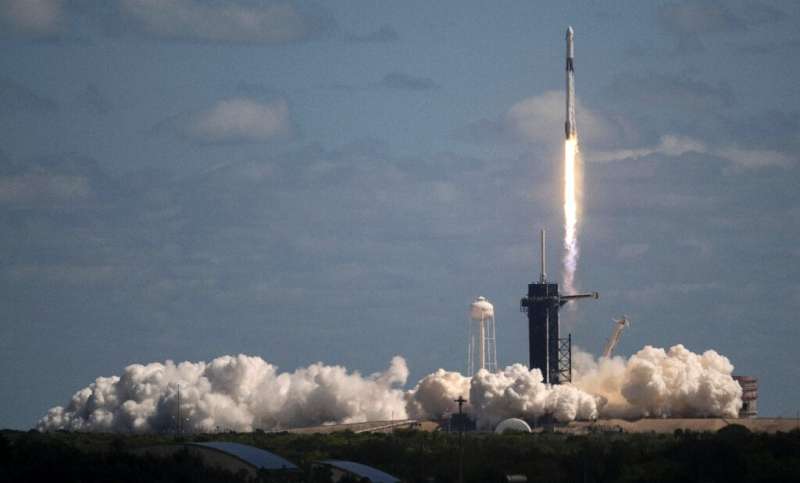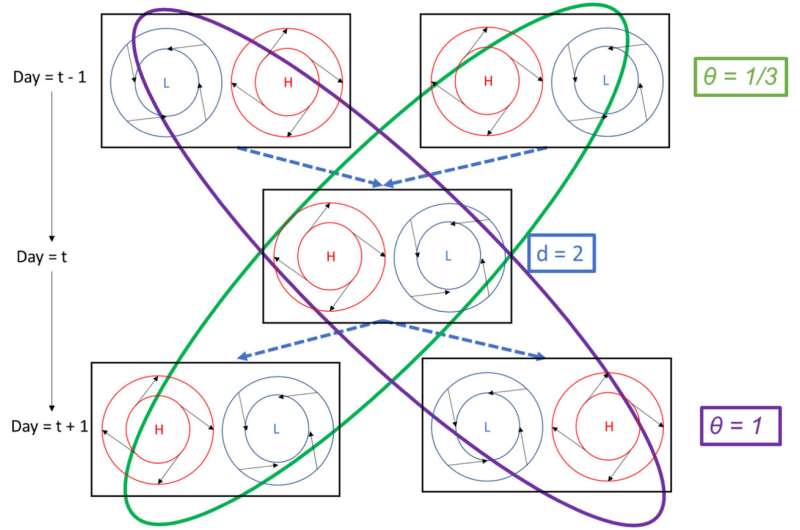
Copernical Team
NASA's Curiosity Mars rover reaches long-awaited salty region

After journeying this summer through a narrow, sand-lined pass, NASA's Curiosity Mars rover recently arrived in the "sulfate-bearing unit," a long-sought region of Mount Sharp enriched with salty minerals.
Scientists hypothesize that billions of years ago, streams, and ponds left behind the minerals as the water dried up. Assuming the hypothesis is correct, these minerals offer tantalizing clues as to how—and why—the Red Planet's climate changed from being more Earth-like to the frozen desert it is today.
European Space Agency to launch two missions on SpaceX rockets

The European Space Agency announced Thursday it will use SpaceX's Falcon 9 rockets to launch two scientific missions because of delays to its own Ariane 6 rocket and the cancellation of flights on Russia's Soyuz launchers.
The ESA's space telescope Euclid had been planned to launch next year on a Soyuz rocket, but in February Russia pulled out in response to European sanctions over Moscow's war in Ukraine.
Euclid, which aims to better understand the mysteries of dark energy and dark matter, will now instead catch a ride into space on the Falcon 9 rocket of billionaire Elon Musk's US company SpaceX.
The ESA's Hera mission, which will probe the Didymos asteroid that NASA successfully knocked off course in September by smashing the DART spacecraft into it, will launch on a Falcon 9 in late 2024, ESA director general Josef Aschbacher said.
Looking to move to a galaxy far, far away? An innovative system evaluates habitability of distant planets

NASA extends contract with Planet Labs granting access to EO data to 300,000 scientists
 Planet Labs PBC (NYSE:PL), a leading provider of daily data and insights about Earth, reports that NASA has exercised an option to extend its contract with Planet under the Commercial SmallSat Data Acquisition (CSDA) Program through September 2023.
Planet has been providing data to NASA scientists and federally funded researchers under this program since 2018 and the company looks forward
Planet Labs PBC (NYSE:PL), a leading provider of daily data and insights about Earth, reports that NASA has exercised an option to extend its contract with Planet under the Commercial SmallSat Data Acquisition (CSDA) Program through September 2023.
Planet has been providing data to NASA scientists and federally funded researchers under this program since 2018 and the company looks forward Distribution partners selected for Inmarsat's SwiftJet Business Aviation Inflight Connectivity Service
 Inmarsat's ground-breaking new SwiftJet inflight connectivity service for the business aviation market has passed an important milestone, after industry heavyweights Satcom Direct and Honeywell were named as the first global distribution partners.
The announcement comes less than five months after SwiftJet was launched as the world's fastest business aviation inflight connectivity service
Inmarsat's ground-breaking new SwiftJet inflight connectivity service for the business aviation market has passed an important milestone, after industry heavyweights Satcom Direct and Honeywell were named as the first global distribution partners.
The announcement comes less than five months after SwiftJet was launched as the world's fastest business aviation inflight connectivity service Viasat and Inmarsat will work with CMA to demonstrate customer benefits of proposed transaction
 Viasat Inc. (NASDAQ: VSAT) and Inmarsat report they are working with the UK's Competition and Markets Authority (CMA) to demonstrate how the planned combination of the companies will benefit customers by improving efficiencies, lowering costs, and increasing the availability of in-flight connectivity (IFC) around the world.
The CMA announced today it will refer the transaction to a Phase 2
Viasat Inc. (NASDAQ: VSAT) and Inmarsat report they are working with the UK's Competition and Markets Authority (CMA) to demonstrate how the planned combination of the companies will benefit customers by improving efficiencies, lowering costs, and increasing the availability of in-flight connectivity (IFC) around the world.
The CMA announced today it will refer the transaction to a Phase 2 Astronomers create new technique to assist in search for dark matter
 Meteors may help astronomers devise a new way to locate dark matter - mysterious and invisible particles that have so far only been discerned by the effect they have on the natural world.
Five times more prevalent than ordinary matter, dark matter makes up about 85% of the total mass of the universe, and about a quarter (26.8%) of the universe's total mass and energy. Humans are unable to
Meteors may help astronomers devise a new way to locate dark matter - mysterious and invisible particles that have so far only been discerned by the effect they have on the natural world.
Five times more prevalent than ordinary matter, dark matter makes up about 85% of the total mass of the universe, and about a quarter (26.8%) of the universe's total mass and energy. Humans are unable to New tool allows scientists to peer inside neutron stars
 Imagine taking a star twice the mass of the Sun and crushing it to the size of Manhattan. The result would be a neutron star-one of the densest objects found anywhere in the Universe, exceeding the density of any material found naturally on Earth by a factor of tens of trillions.
Neutron stars are extraordinary astrophysical objects in their own right, but their extreme densities might als
Imagine taking a star twice the mass of the Sun and crushing it to the size of Manhattan. The result would be a neutron star-one of the densest objects found anywhere in the Universe, exceeding the density of any material found naturally on Earth by a factor of tens of trillions.
Neutron stars are extraordinary astrophysical objects in their own right, but their extreme densities might als Webb takes star-filled portrait of pillars of creation
 NASA's James Webb Space Telescope has captured a lush, highly detailed landscape - the iconic Pillars of Creation - where new stars are forming within dense clouds of gas and dust. The three-dimensional pillars look like majestic rock formations, but are far more permeable. These columns are made up of cool interstellar gas and dust that appear - at times - semi-transparent in near-infrared ligh
NASA's James Webb Space Telescope has captured a lush, highly detailed landscape - the iconic Pillars of Creation - where new stars are forming within dense clouds of gas and dust. The three-dimensional pillars look like majestic rock formations, but are far more permeable. These columns are made up of cool interstellar gas and dust that appear - at times - semi-transparent in near-infrared ligh SwRI scientists compile Cassini's unique observations of Saturn's rings
 Southwest Research Institute scientists have compiled 41 solar occultation observations of Saturn's rings from the Cassini mission. The compilation, published recently in the scientific journal Icarus, will inform future investigations of the particle size distribution and composition of Saturn's rings, key elements to understanding their formation and evolution.
"For nearly two decades, N
Southwest Research Institute scientists have compiled 41 solar occultation observations of Saturn's rings from the Cassini mission. The compilation, published recently in the scientific journal Icarus, will inform future investigations of the particle size distribution and composition of Saturn's rings, key elements to understanding their formation and evolution.
"For nearly two decades, N 
